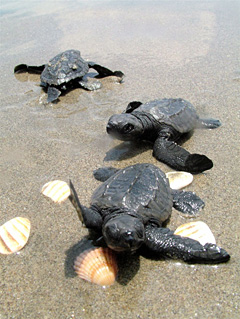
|  |  |  Editorials | Environmental | September 2009 Editorials | Environmental | September 2009  
Ecology Watch Dog: Nayarit Turtle Talk
 Carol Davenport - PVNN Carol Davenport - PVNN
September 11, 2009


| | For more information on how you can be a part of marine conservation please contact me at
carol_davenport(at)hotmail.com. |  |
In the state of Nayarit, Mexico there is much to be discovered, respected, and cared for. The marine life on the bay, hosts a wealth of history, stories, fascinations, and beauty. In addition, man has neglected the responsibilities and the importance of all life forms.

In the governmental office of CRIP (National Fisheries Institute) marine biologist Dr. Javier Tovar discusses and educates those who will listen, about the importance of marine life. According to Dr. Tovar, the selections of species that were gathered 10 to 15 years ago, some are no longer living in the bay today.

There are many reasons why the marine life is suffering and we will be covering different topics, species, and studies to allow the general public to be aware and see how each one of us can make a difference.

The Banderas Bay (The Bay of Flags) is the third largest bay in the world. The bay stretches from the point of Punta de Mita, which is nestled in the foothills of Sierra de Vallejo Mountains, and to south of Puerto Vallarta extending to Cabo Corrientes, part of the foothills of the Sierra del Cuale Range. The expansion of 160 km of coastline, 42 km from east to west, and 33 km from north to south. Please, let's take action now, and not allow it to become a dead bay.

Sea Turtle Conservation in Nayarit

At one time, there were 250 known species of sea turtles in the world. Today, there are only 8 existing species of sea turtles in the world. Of the 8 species of sea turtles, 7 come to Mexico to make their nests! Do I have your attention now?

The sea turtles are in critical danger of being extinct. Yet, in some parts of the world, they are still considered a delicacy for an evening meal. The fact is they are near extinction.

In the state of Nayarit, Mexico, there are three species of sea turtles specifically protected by the Mexican authorities; Olive Ridley (Lepidochelys oliacea), the Hawksbill, (Eretmochelys imbricate) and the Leatherback (Dermochelys coreacea). It is the Olive Ridley, the smallest of the sea turtles that is most tangible of the three due to the high number of nesting turtles. They appear to be the least sensitive to their surroundings than the other turtles.

Out of the 286 km (178 mi) of coastline, 53 km (33 mi) are under formal programs of sea turtle management. Since the 1970's Mexico has taken legal actions and steps in the protection of sea turtles. There are seven turtle preserve conservations being administered in Nuevo Vallarta and Platanitos beaches monitored by the government office of CONANP (Mexico's Commission for the Protection of Natural Areas) under the Ministry of Environment and Natural Resources (SEMARNAT), helped managed by committed non-governmental organizations. Though Nuevo Vallarta's beach is not a protected area, it does fall under CONANP's jurisdiction due to the importance of the sea turtle preserve.

In Mexico, it is illegal to touch a turtle, egg, or buy turtle products. Their eggs are protected; however, the problem of poachers is a very threat to their existence. The Mexican tradition believes the high protein found in eggs creates aphrodisiacs; however, this is a myth, and it would give thousands of turtles a year a chance to life, if people would go to the local drug store and purchase Viagra. Some biologist have joked that they should bury eggs filled with Viagra and leave them for the poachers!

The highest nesting months are in process now, from August 15th through October 15th; the numbers along the beach from Nuevo Vallarta and Bucerias, an average of 100 nests can be gathered to return to the protective turtle camp.

It is during these two months that the local restaurants and individuals have offered their support in providing meals to the volunteers that are working all night and throughout the early mornings gathering nests.

A personal thank you goes to Larry & Lorena Hurlingman, and Ross & Kim Cable for their commitment of buying pizzas for the group on a designated night! The local area businesses showing their support through generous contributions of food and drinks are: Starbucks, Tutto Pronto, Nopalitos Restaurant & Bar (Paradise Village) and Claudio Mesa Bay. Please show your appreciation and visit these restaurants.

For more information on how you can be a part of marine conservation please contact me at carol_davenport(at)hotmail.com. |

 |
|  |



